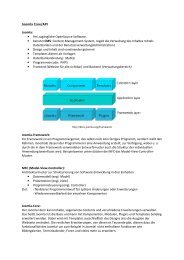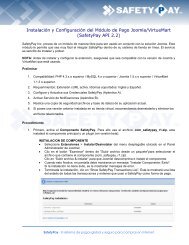Akeeba Kickstart 3.0 User's Guide - JoomlaCode
Akeeba Kickstart 3.0 User's Guide - JoomlaCode
Akeeba Kickstart 3.0 User's Guide - JoomlaCode
You also want an ePaper? Increase the reach of your titles
YUMPU automatically turns print PDFs into web optimized ePapers that Google loves.
Chapter 1. Introduction<br />
1. Overview<br />
<strong>Kickstart</strong> is a PHP executable file ( script ) use to automate the steps required before and after the restoration of site<br />
backed up with <strong>Akeeba</strong> Backup in a great extent. It can be used as a simple and efficient method of extracting the<br />
<strong>Akeeba</strong> Backup archives directly on the target server, or even used to extract other archive files including CMS and<br />
script installation files (e.g. Joomla!, WordPress, Drupal, phpBB), update packages (Joomla! and WordPress can<br />
especially benefit from this use) or even archives containing large amounts of files you need to get on your server, fast.<br />
When used with backup archives, <strong>Kickstart</strong> streamlines the archive extraction - uploading - restoration - postrestoration<br />
workflow by allowing you to omit unnecessary steps. As a matter of fact, you only need to upload <strong>Kickstart</strong><br />
and the backup archive on the server you want to restore your site to. <strong>Kickstart</strong> will extract (i.e. "unzip") the archive<br />
right on the server , rename your .htaccess and php.ini files and give you a button to start the restoration script<br />
included in the backup archive (for example, <strong>Akeeba</strong> Backup Installer). When you're done with the restoration script,<br />
you click on the new button appearing on the <strong>Kickstart</strong> interface and it will rename back your .htaccess and php.ini<br />
files, remove the installation directory, delete the backup archive and finally remove itself as well. Housekeeping is<br />
taken care of itself!<br />
<strong>Kickstart</strong> is also localisable, meaning that it can display itself in your own language. All you have to do is to upload<br />
your language's translation INI file in the same directory as kickstart.php .<br />
2. Why do we need <strong>Kickstart</strong>, anyway?<br />
Even though <strong>Akeeba</strong> Backup is designed as an effortless way of backing up your site, it is only good up to the point<br />
of having a backup archive. Restoring it is a pretty much different story.<br />
At first, you have to download the file to your PC. Then extract it. Then upload all the files, via FTP, to you site (and,<br />
man, this is slow or what?). Then rename .htaccess to htaccess.txt and php.ini to php.ini.bak in<br />
order to avoid any conflicts. Go through the restoration process, which is the easy part. Then remove the installation<br />
directory. Finally, rename htaccess.txt to .htaccess and php.ini.bak to php.ini.<br />
Did you notice something? Most of this is a common predefined procedure. The only human intervention truly required<br />
is for the restoration process part. Moreover, FTP'ing all those 3000+ files of even the smallest full site backup is an<br />
overkill. Because of all of this, <strong>Kickstart</strong> was born.<br />
<strong>Kickstart</strong> works in conjunction with the ZIP / JPA archives, directly on the target server. Nothing else is<br />
required. You just upload kickstart.php and your archive to the server, visit http://www.yourdomain.com/<br />
kickstart.php, select the archive, wait, go through the restoration process, click the cleanup button and presto!<br />
Your site is up and running; the kickstart.php, the backup archive and the installation folder all gone, automatically.<br />
Even the .htaccess and php.ini renaming took care of itself. Isn't this too good to be true?<br />
Well, almost. You actually need to either turn off PHP Safe Mode, or make sure the target folder is owned by the same<br />
user as the one your web server runs on: this is a PHP limitation we can't overcome. Alternatively, you can supply FTP<br />
connection information and <strong>Kickstart</strong> will use the - much slower - FTP mode to write the extracted files to your site.<br />
3. What <strong>Kickstart</strong> is and what it's not<br />
<strong>Kickstart</strong> is an interactive archive extraction script and a clean-up tool. Counter-intuitively, it is not a site restoration<br />
utility per se. <strong>Kickstart</strong> performs the steps required before and after site restoration, whereas the site restoration<br />
procedure itself is carried out by the installer script which was included in your backup archive at backup time. To<br />
make it crystal clear, here is the flow of a <strong>Kickstart</strong>-powered site restoration procedure:<br />
1




